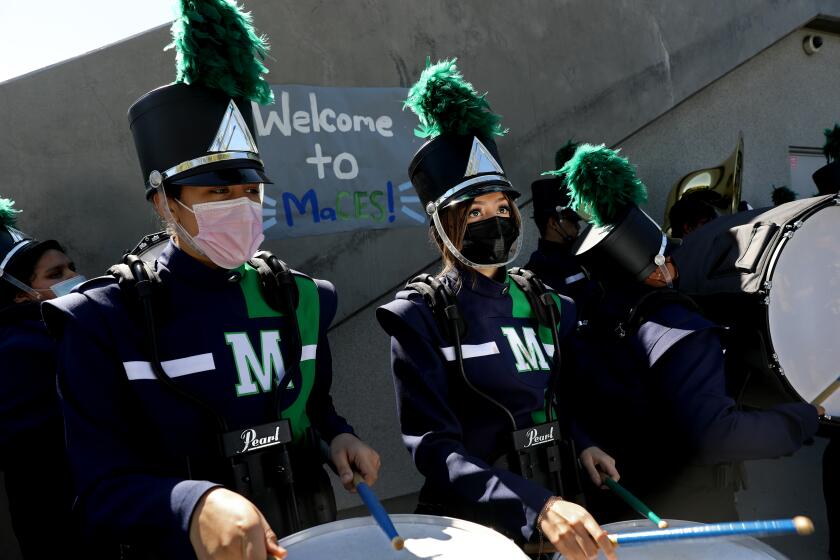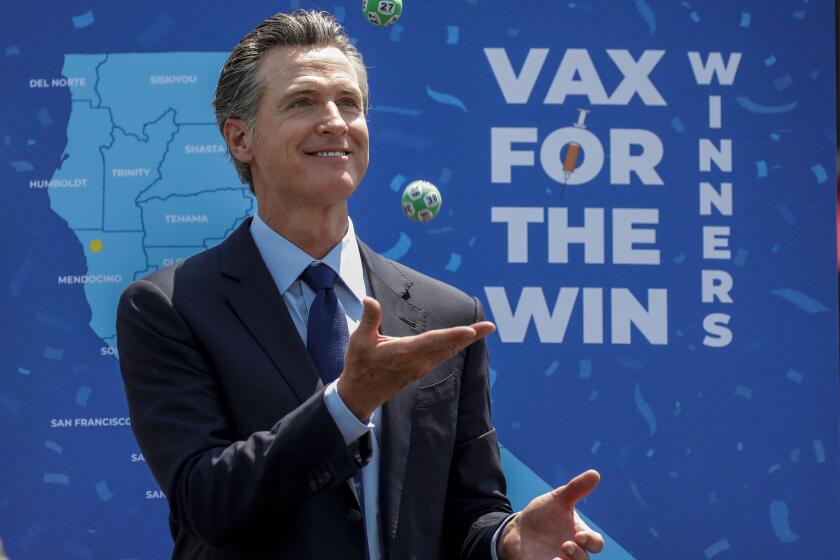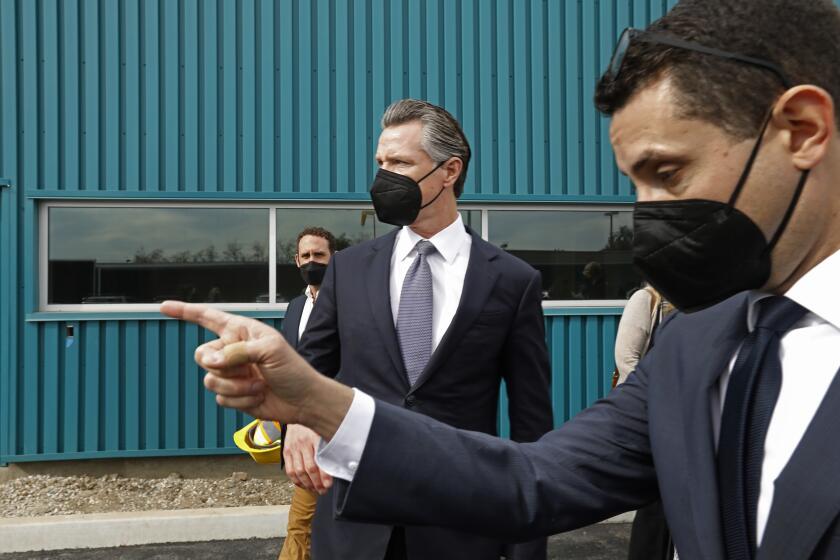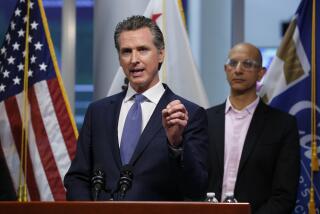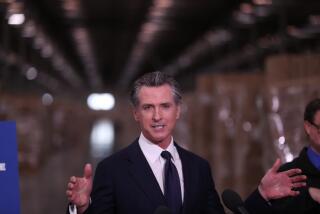‘There is no end date.’ Newsom’s new COVID-19 plan looks to balance hope and reality

With so little known about how the virus will behave in the future, the governor’s more cautious approach is intended to discourage people from letting down their guard.
- Share via
SACRAMENTO — Gov. Gavin Newsom struck a circumspect tone Thursday when he announced California’s plans to monitor and respond to COVID-19 indefinitely after removing most statewide restrictions and rules.
The scene was a far cry from last summer when he proclaimed at a reopening celebration at Universal Studios alongside costumed characters that the state had “turned the page” on the pandemic, just months before the worst wave of the virus forced him to backpedal.
This time there were no Minions, Trolls or Transformers.
“We have all come to understand what was not understood at the beginning of this crisis, that there is no end date, that there is not a moment where we declare victory,” he said at a news conference from an emergency supplies warehouse in Fontana.
After a 2020 shutdown and a hasty reopening, a “toggle” back to restrictions and then an all-too-optimistic move toward pre-COVID normality, a return to and now repeal of the mask mandate and countless iterations of rules along the way, Newsom is attempting to strike a balance between providing hope to tired Californians as the Omicron variant wanes and avoiding past mistakes of suggesting an end to the pandemic.
The governor’s more cautious approach is intended to discourage people from dropping their precautions with so little known about how the virus will behave in the future.
“We’ve learned a lot,” Newsom said. “We’re not approaching things the way we approached it last year, certainly not two years ago.”
California officials outline a plan that assumes the coronavirus and its variants will ebb and flow, requiring flexibility in such activities as mask wearing.
The governor’s new “SMARTER” plan is summed up in a seven-part strategy that includes continued reliance on vaccinations, masks and testing. The state will keep track of COVID-19 trends and remain ready to adapt as necessary, work to keep schools open and improve treatments to the virus, Newsom said.
“We’re gliding into normal,” said Dr. Mark Ghaly, California’s secretary of Health and Human Services. “We’re not announcing the normal.”
Ghaly warned that California isn’t out of the woods and could require masks again in certain settings if another variant hits and the virus surges again. He and Newsom were careful to not offer any rosy predictions.
It’s more measured messaging than in May 2020, when Newsom began to loosen his stay-at-home order and reopen businesses, only to see case counts spike.
Vaccines weren’t available then and the state was too slow to roll out its public education campaign around the need to continue virus mitigation strategies when Newsom began rescinding rules, said Ann O’Leary, his then chief of staff.
When the governor announced the imminent reopening of businesses and what he called Stage 2 in early May, he faced pressure from all sides. Some local public health officials wanted to keep the stay-at-home order in place and a vocal faction of frustrated residents and a few local governments openly defied his restrictions. More than 3.5 million Californians had filed for unemployment benefits and businesses across the state worried they couldn’t survive a continued shutdown.
Within weeks of reopening, the daily average of new positive cases in California nearly quintupled by the Fourth of July holiday weekend.
“If I have a critique of us, I think even the governor has a critique of what we did that first time around, it was that we just didn’t do enough public education around what it meant to reopen,” O’Leary said. “People really thought it meant that the pandemic was over or that the threat was over.”
As cases surged that summer, Newsom relied on a series of evolving criteria — stages, watchlists and eventually colored tiers for counties — to impose or roll back mitigation strategies in areas experiencing elevated virus transmission.
Later, after a winter spike and months into a vaccination campaign, the governor again called off nearly all of his rules and mandates the following summer.
On June 15, a maskless Newsom stood in front of the entrance to the Universal Studios theme park and told Californians it was safe to take their masks off, too.
“Finally, we are here ... to turn the page, to move beyond capacity limits, to move beyond this color coding, to move beyond social distancing and physical distancing, and yes, as you saw me walk up to the stage, move beyond mask coverings,” Newsom told the crowd last year.
The governor’s reopening frenzy and end to mitigation strategies in the middle of a recall campaign would later prove premature. At the time, Newsom’s public health advisors and many other experts said it was unlikely that the state would experience the kind of surge that forced businesses to close again.
Given California’s low coronavirus infection rates and high vaccination levels, Newsom’s move to rescind restrictions will likely ensure that the shutdowns and political missteps that helped fuel dissension fade into memories by the time voters head to the polls for a recall election, political observers say.
“The hope was that we were going to make much more progress on vaccinations,” said state Sen. Richard Pan (D-Sacramento). “There was some cautious optimism that with a high enough vaccination rate, then we could lift a lot of the other mitigations.”
The celebration sent the message that the pandemic was in the past and many Californians responded accordingly. The once optimistic public health outlooks became more grim when vaccinations slowed, and it became clear that the inoculated would continue to catch and spread the virus.
The state never shut down businesses again. But bolstered by the overwhelming support for his more cautious COVID-19 approach than that of his recall challengers, the governor committed to a vaccination mandate for schoolchildren two weeks after the election and followed in December with a mask mandate to slow a winter Omicron surge.
Pan said the state should have done a better job at normalizing masks even when risks lessened. He said governments have mitigated the spread of other diseases and public health concerns for decades and people shouldn’t expect COVID-19 to be any different.
“No one wants to return to a time when we don’t have clean water and sewer systems and regulations on food quality, food cleanliness standards and all these other things that we put in place to stop diseases,” Pan said. “We need to think about what’s effective in stopping the spread of this disease.”
Throughout the pandemic, Newsom and public officials have been pressured to lift restrictions from some business owners and a vocal minority of Californians who have remained opposed to most forms of government intervention.
But a recent poll suggests Newsom’s decision to end mask mandates could in fact be coming too quickly for many of his supporters.
Around the same time the state said it planned to remove the indoor mask mandate for vaccinated Californians on Feb. 15, only 20% of registered voters said the pandemic had subsided enough to remove special precautions, such as masks, in public settings, according to a UC Berkeley Institute of Governmental Studies poll co-sponsored by the Los Angeles Times. Those respondents included only 6% of Democrats polled and 46% of Republicans. The vast majority of Democrats, 41%, said they didn’t believe it would be safe enough to do so until next year.
Concerns about rising crime and the homelessness crisis emerged as the top issues driving voter dissatisfaction with Gov. Gavin Newsom.
A breakdown of that question showed that those who approved of Newsom’s performance as governor were also much more likely to say it wouldn’t be safe to remove masks indoors until next year, while those who disapproved strongly were much more likely to say it is already safe enough.
“I would say he’s somewhat ahead of his base,” said Mark DiCamillo, director of the poll. “Things getting back to normal would benefit jobs and the economy, which is usually in an election year the No. 1 issue that the incumbent wants to take care of. He’s running for reelection, and he wants the economy to return.”
DiCamillo said Newsom is being “impatient” like some but not all voters and doesn’t want to give his GOP critics any room.
“One of the reasons he’s getting out in front is because he’s anticipating criticism from the Republican camp when he’s running in the primary and then ultimately in the general election and he needs to kind of defend himself or inoculate himself from the attacks,” DiCamillo said.
Newsom has built his career on a reputation that he’s ahead of the curve, demonstrated by his early support for gay marriage in San Francisco and as the first governor to issue a statewide stay-at-home order when the virus hit in 2020.
But DiCamillo and others warn that being too far ahead of California’s pandemic comfort level could be problematic for a governor who has received praise for his health-first approach. Out of more than a half-dozen issues surveyed in the poll, the governor received among the highest marks for his handling of the COVID-19 pandemic.
Pan said the poll shows those who want to remove mask rules now are many of the same people who have opposed vaccine requirements for years and resisted most of the governor’s orders. A larger share of Californians who are still concerned about the virus and comfortable with precautions might not be as loud, but they will weigh in on election day.
“I think that if for some reason we prematurely lift the mask mandates and the cases go up, while they’re not going to be necessarily marching around the Capitol, I think at the ballot box they’re gonna be like, ‘You guys mishandled this pandemic and you put my family at risk,’” Pan said. “In fact, they made their voices heard when Gov. Newsom ran on vaccine mandates and strong public health in the recall and he crushed the opposition.”
More to Read
Sign up for Essential California
The most important California stories and recommendations in your inbox every morning.
You may occasionally receive promotional content from the Los Angeles Times.
